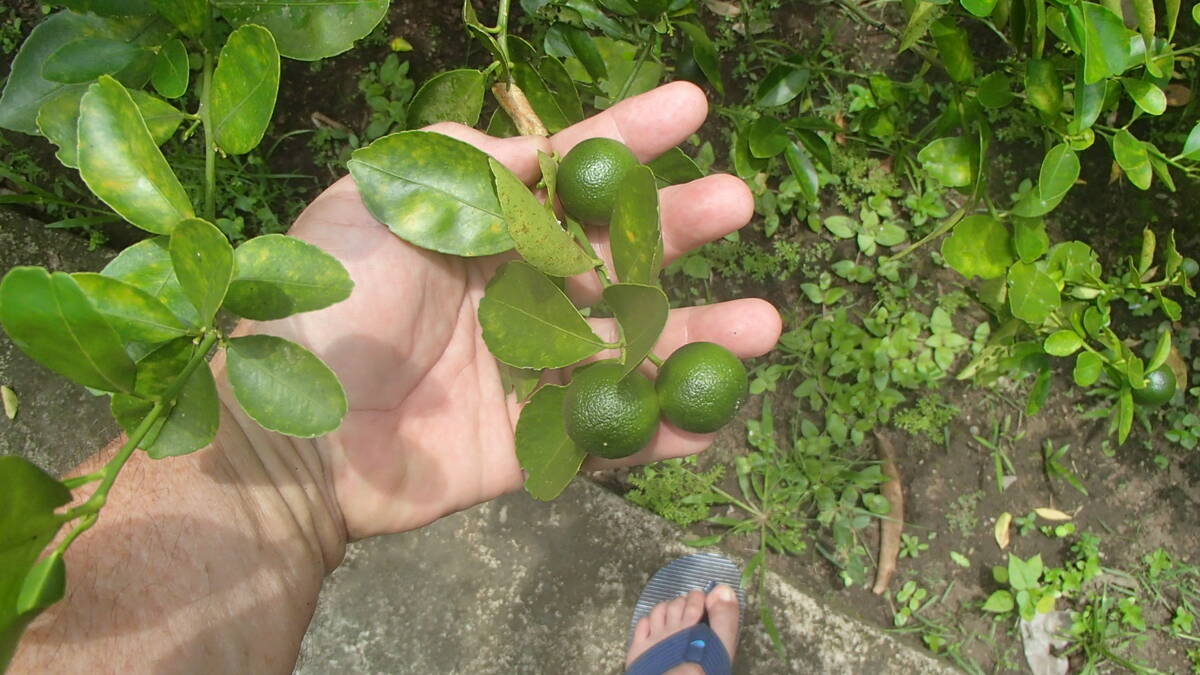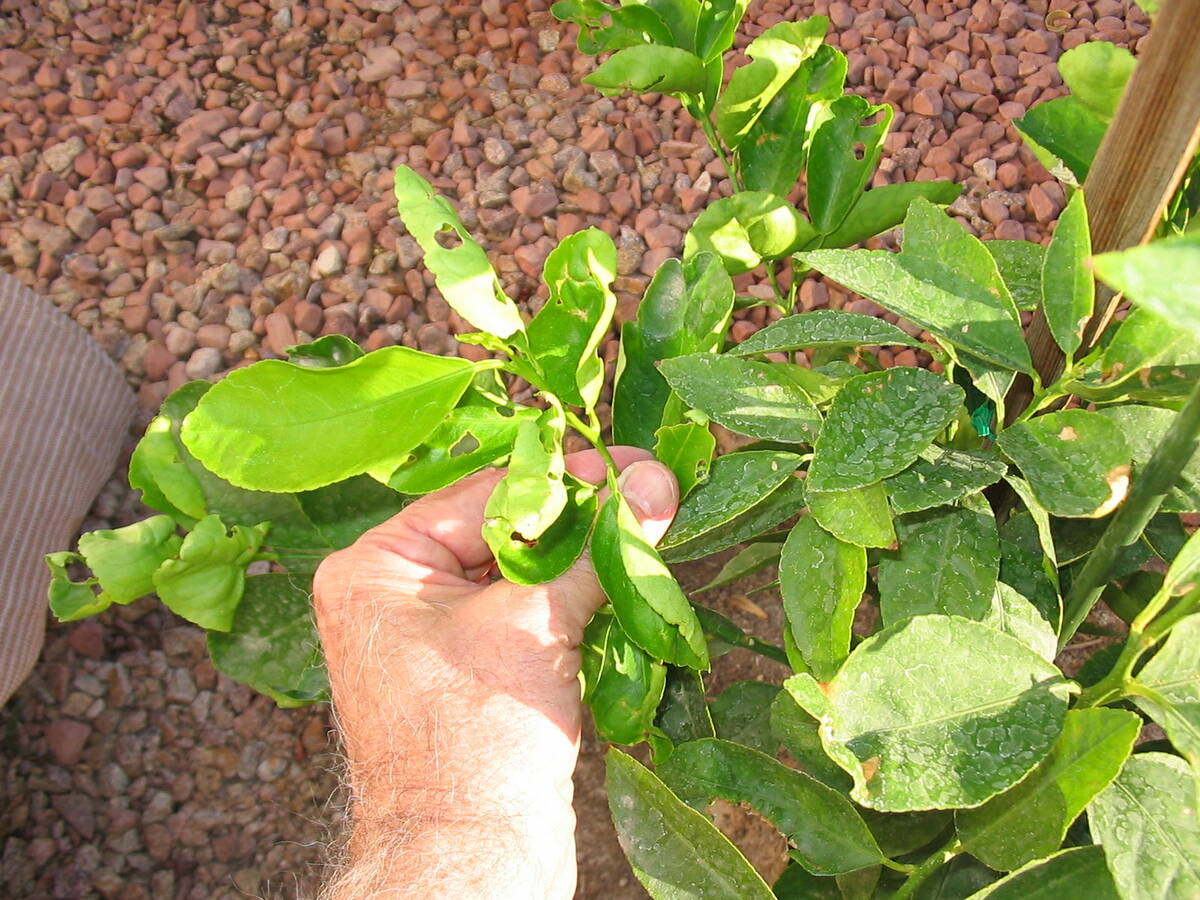Harvest limes when fruit is firm, green and juicy
There are limes that should be green when you pick them and limes that should have a yellowish hue when harvested and juicy. When limes are harvested too late, they are yellowish, pithy and no longer juicy and light in weight. But for the most part, limes are harvested green.
Like Meyer lemon, there are crosses between oranges and limes too, such as the Rangpur lime. Unlike most temperate fruit trees like apples, pears, apricots, plums and peaches, citrus oftentimes sprouts true from seed and freely crosses with each other. This feature is sometimes used by orchardists in subtropical areas to manipulate them.
Most of the lime trees from the nursery are the sour type, but did you know there are sweet limes as well? The term “sweet lime” is rather a misnomer because it is not usually as flavorful as a sour lime; oftentimes they are called Indian or Palestinian limes.
They are a little less common when you looking to buy a lime tree, but they are out there. And if you are thinking of propagating your own lime, like most citrus, they will come true from seed unlike most of our temperate fruit trees.
There are two basic kinds of sour limes to buy: the Tahiti lime and the Mexican, aka Key, lime. In botanical terms there is no such thing as a Persian lime or the seedless Bearss lime; they are both considered a Tahiti lime.
The term Persian lime is used more for marketing. Tahiti limes should be harvested when the skin turns from dark green to a slightly lighter green — just a different shade of green.
The Mexican or Key lime has a bit more yellowish color in its skin when harvested than Tahiti limes. They are still green but with that definite yellowish hue I was talking about. The fruit is still firm and not spongy at all, but there may be a definite yellow color change to the skin.
Overripe limes can become much yellower than dark green, but the fruit will be spongy when you squeeze it, a sure sign the fruit will be pithy and dry on the inside. When harvesting limes, the fruit should be firm, green and juicy.
Q: I found a calamansi fruit tree for sale in one of our local Asian food markets. Will it grow in Las Vegas?
A: Calamansi, sometimes called calamondin, is a lime tree native to the Philippines and a frequent flavoring as a beverage or for enhancing the flavor of fish. With orangish-green flesh when ripe, it is considered a sour lime but has the flavor of lemon and tart orange combined with lime. The tree is small, suitable for container growing, more cold hardy than Tahiti or Mexican limes and frequently found for sale in Filipino and other Asian food markets.
As far as its cold tolerance, the difference won’t be noticeable to most homeowners, but calamansi is slightly more cold-tolerant than sour limes. Where sour limes won’t handle temperatures much below freezing in the winter, calamansi can tolerate a few more degrees colder during the middle of winter.
Like most citrus in our valley, survival can be hit or miss with citrus here. It depends on your local microclimate, weather conditions and protection from the wind.
Q: My peach tree was heavily pruned two years ago, making it less disease-resistant. I thought we were OK as it had great leaves and fruit since then. Returning after two months away, and it looks sick. Any thoughts?
A: Most likely the decline was from boring insects (borers) and not a disease. Let me explain why it took two years after pruning and I think it is probably not a disease. Notice I say “probably not” disease because it could be a disease, but that is less likely. Because our dry, desert climate does not favor many diseases, disease damage is less common than damage from insects.
When good-sized peach trees are not pruned carefully, this pruning will oftentimes open up the trunk and limbs for damage from our intense desert sunlight.
Before pruning, this sunlight was captured by the leaves of the tree. Leaves cool themselves by evaporating water from their surfaces. Limbs without leaves have no way to cool themselves and can get very hot, quickly, starting in the spring. The leaves provided necessary shade to the lower limbs otherwise they die
This combination of dying and living wood provides perfect conditions for survival of the wood-chomping babies of the egg-laying female. The adult boring insect lays her eggs in these locations.
Because the limbs of mature peach trees are large, they can survive several attacks of the egg-laying female over several years before any outward visible sign is seen. The sign of borers starts occurring when it gets hot and activity is at its peak, usually starting in July.
Pruning dead limbs close to where they are living will reveal exit holes or the boring babies now mature and ready to pupate into flying adult beetles. Dig them out of these limbs with a sharp, sanitized knife or replace the tree or treat the tree with a soil-drench insecticide and follow labeled directions.
Q: We planted a pomegranate bush a few years ago. Last year we had blossoms that turned into fruit, but when we picked them in late fall, the fruit was too hard to enjoy. Since it was the first growing season, we felt just happy to have it growing well and blossoms on it. This year we had fewer blossoms and no fruit at all, but our neighbor’s older bushes are loaded with fruit. What went wrong? Do you think we need a second bush nearby for cross-pollination?
A: Pomegranates are a safe bet to plant in our climate. They are hardy to 15 to 20 degrees (depending on the variety), they can handle our heat, and they produce flowers most of the planting season. There are a couple of precautions about pomegranates that might interest you and affect your situation.
Flowering. Pomegranates make flowers on new growth. This is the reason why you see flowers on them much of the summer. This is a good thing and a bad thing. Flowers producing fruit late in the season can produce fruit that is not ready to pick at the end of its season. As it gets older, flowering will start earlier and be more consistent.
Pruning. Prune a pomegranate so that it has five major stems coming from the ground. Remove any growth younger than this. The best and largest fruit will be produced from the larger and older stems coming from the ground.
Fruiting. Fruiting can start when the plant is young, but the best fruit is produced when it gets older. Be patient. Give it three to five years after planting to evaluate its fruit.
Fertilizing. Lightly fertilize once in early spring. Fertilizing pomegranate may cause it to flower later when it is young and delay fruiting. The year when pomegranate starts to produce fruit that you like is the year to increase your fertilizer to “normal” amounts.
Q: I decided to plant wildflowers for the fall and winter where my garden was all summer. I rototilled the ground and used a couple of bags of wildflower seed and added some mulch on top. I now have wildflowers, but spurge (weed) predominates. Is there a way to eliminate the spurge and other unwanted plants before planting?
A: There is no way to eliminate spurge once it is established except by hoeing or removing by hand. The best and only way to eliminate spurge from a garden area is to either hoe until the desirable plants you want to keep are a few inches tall and then cover the soil with at least 2 inches of mulch or use a pre-emergent herbicide. As the name suggests, pre-emergent herbicides keep seeds from sprouting, both the ones you want and the ones you don’t want.
Another way is to grow your desirable plants to a few inches in height, prepare the soil, plant as transplants and then either cover the soil with a mulch or use a pre-emergent weed killer. Remember, the key to using a pre-emergent weed killer is to leave the soil undisturbed after making the application. Disturbing the soil allow for weeds to grow in those areas.
Bob Morris is a horticulture expert and professor emeritus of the University of Nevada, Las Vegas. Visit his blog at xtremehorticulture.blogspot.com. Send questions to Extremehort@aol.com.



















